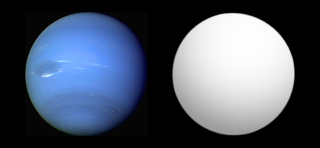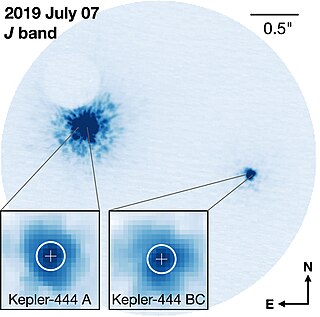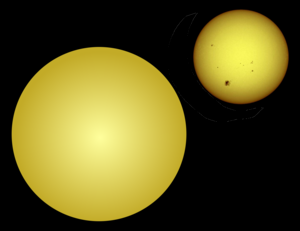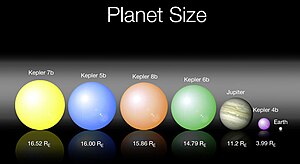
Kepler-7b is one of the first five exoplanets to be confirmed by NASA's Kepler spacecraft, and was confirmed in the first 33.5 days of Kepler's science operations. It orbits a star slightly hotter and significantly larger than the Sun that is expected to soon reach the end of the main sequence. Kepler-7b is a hot Jupiter that is about half the mass of Jupiter, but is nearly 1.5 times its size; at the time of its discovery, Kepler-7b was the second most diffuse planet known, surpassed only by WASP-17b. It orbits its host star every five days at a distance of approximately 0,06 AU. Kepler-7b was announced at a meeting of the American Astronomical Society on January 4, 2010. It is the first extrasolar planet to have a crude map of cloud coverage.

Kepler-4b, initially known as KOI 7.01, is an extrasolar planet first detected as a transit by the Kepler spacecraft. Its radius and mass are similar to that of Neptune; however, due to its proximity to its host star, it is substantially hotter than any planet in the Solar System. The planet's discovery was announced on January 4, 2010, in Washington, D.C., along with four other planets that were initially detected by the Kepler spacecraft and subsequently confirmed by telescopes at the W.M. Keck Observatory.

Kepler-5b is one of the first five planets discovered by NASA's Kepler spacecraft. It is a hot Jupiter that orbits a subgiant star that is more massive, larger, and more diffuse than the Sun is. Kepler-5 was first flagged as the location of a possibly transiting planet, and was reclassified as a Kepler Object of Interest until follow-up observations confirmed the planet's existence and many of its characteristics. The planet's discovery was announced at a meeting of the American Astronomical Society on January 4, 2010. The planet has approximately twice the mass of Jupiter, and is about 1.5 times larger. It is also fifteen times hotter than Jupiter. Kepler-5b orbits Kepler-5 every 3.5 days at a distance of approximately 0.051 AU.

Kepler-6b is an extrasolar planet in the orbit of the unusually metal-rich Kepler-6, a star in the field of view of the NASA-operated Kepler spacecraft, which searches for planets that cross directly in front of, or transit, their host stars. It was the third planet to be discovered by Kepler. Kepler-6 orbits its host star every three days from a distance of .046 AU. Its proximity to Kepler-6 inflated the planet, about two-thirds the mass of Jupiter, to slightly larger than Jupiter's size and greatly heated its atmosphere.

Kepler-8b is the fifth of the first five exoplanets discovered by NASA's Kepler spacecraft, which aims to discover planets in a region of the sky between the constellations Lyra and Cygnus that transit their host stars. The planet is the hottest of the five. Kepler-8b was the only planet discovered in Kepler-8's orbit, and is larger than Jupiter. It orbits its host star every 3.5 days. The planet also demonstrates the Rossiter–McLaughlin effect, where the planet's orbit affects the redshifting of the spectrum of the host star. Kepler-8b was announced to the public on January 4, 2010 at a conference in Washington, D.C. after radial velocity measurements conducted at the W.M. Keck Observatory confirmed its detection by Kepler.
Kepler-4 is a sunlike star located about 1626 light-years away in the constellation Draco. It is in the field of view of the Kepler Mission, a NASA operation purposed with finding Earth-like planets. Kepler-4b, a Neptune-sized planet that orbits extremely close to its star, was discovered in its orbit and made public by the Kepler team on January 4, 2010. Kepler-4b was the first discovery by the Kepler satellite, and its confirmation helped to demonstrate the spacecraft's effectiveness.
Kepler-5 is a star located in the constellation Cygnus in the field of view of the Kepler Mission, a NASA project aimed at detecting planets in transit of, or passing in front of, their host stars as seen from Earth. One closely-orbiting, Jupiter-like planet, named Kepler-5b, has been detected around Kepler-5. Kepler-5's planet was one of the first five planets to be discovered by the Kepler spacecraft; its discovery was announced on January 4, 2010 at the 215th meeting of the American Astronomical Society after being verified by a variety of observatories. Kepler-5 is larger and more massive than the Sun, but has a similar metallicity, a major factor in planet formation.

Kepler-6 is a G-type star situated in the constellation Cygnus. The star lies within the field of view of the Kepler Mission, which discovered it as part of a NASA-led mission to discover Earth-like planets. The star, which is slightly larger, more metal-rich, slightly cooler, and more massive than the Sun, is orbited by at least one extrasolar planet, a Jupiter-sized planet named Kepler-6b that orbits closely to its star.
Kepler-8 is a star located in the constellation Lyra in the field of view of the Kepler Mission, a NASA-led operation tasked with discovering terrestrial planets. The star, which is slightly hotter, larger, and more massive than the Sun, has one gas giant in its orbit, Kepler-8b. This gas giant is larger than Jupiter, but is less massive, and thus more diffuse. The planet's discovery was announced to the public on January 4, 2010 along with four other planets. As the fifth confirmed planetary system verified by Kepler, it helped demonstrate the capabilities of the Kepler spacecraft.

Kepler-9 is a sunlike star in the constellation Lyra. Its planetary system, discovered by the Kepler Mission in 2010 was the first detected with the transit method found to contain multiple planets.

Kepler-10, formerly known as KOI-72, is a Sun-like star in the constellation of Draco that lies 607 light-years from Earth. Kepler-10 was targeted by NASA's Kepler spacecraft, as it was seen as the first star identified by the Kepler mission that could be a possible host to a small, transiting exoplanet. The star is slightly less massive, slightly larger, and slightly cooler than the Sun; at an estimated 11.9 billion years in age, Kepler-10 is 2.3 times the age of the Sun.
Kepler-20 is a star about 934 light-years from Earth in the constellation Lyra with a system of at least five, and possibly six, known planets. The apparent magnitude of this star is 12.51, so it cannot be seen with the unaided eye. Viewing it requires a telescope with an aperture of 15 cm (6 in) or more. It is slightly smaller than the Sun, with 94% of the Sun's radius and about 91% of the Sun's mass. The effective temperature of the photosphere is slightly cooler than that of the Sun at 5466 K, giving it the characteristic yellow hue of a stellar class G8 star. The abundance of elements other than hydrogen or helium, what astronomers term the metallicity, is approximately the same as in the Sun. It may be older than the Sun, although the margin of error here is relatively large.

Kepler-42, formerly known as KOI-961, is a red dwarf located in the constellation Cygnus and approximately 131 light years from the Sun. It has three known extrasolar planets, all of which are smaller than Earth in radius, and likely also in mass.

Kepler-90, also designated 2MASS J18574403+4918185, is a G-type star located about 2,790 light-years (855 pc) from Earth in the constellation of Draco. It is notable for possessing a planetary system that has the same number of observed planets as the Solar System.

Kepler-25 is a star in the northern constellation of Lyra. It is slightly larger and more massive than the Sun, with a luminosity 21⁄2 times that of the Sun. With an apparent visual magnitude of 10.6, this star is too faint to be seen with the naked eye.
Kepler-29 is a Sun-like star in the northern constellation of Cygnus. It is located at the celestial coordinates: Right Ascension 19h 53m 23.6020s, Declination +47° 29′ 28.436″. With an apparent visual magnitude of 15.456, this star is too faint to be seen with the naked eye. It is a solar analog, having a close mass, radius, and temperature as the Sun. Currently the age of the star has not been determined due to its 2780 light-year distance. As of 2016 no Jovian exoplanets of 0.9–1.4 MJ have been found at a distance of 5 AU.

Kepler-444 is a triple star system, estimated to be 11.2 billion years old, approximately 119 light-years (36 pc) away from Earth in the constellation Lyra. On 27 January 2015, the Kepler spacecraft is reported to have confirmed the detection of five sub-Earth-sized rocky exoplanets orbiting the main star. The star is a K-type main sequence star. All of the planets are far too close to their star to harbour life forms.

Kepler-452 is a G-type main-sequence star located about 1,800 light-years away from Earth in the Cygnus constellation. Although similar in temperature to the Sun, it is 20% brighter, 3.7% more massive and 11% larger. Alongside this, the star is approximately six billion years old and possesses a high metallicity.
Kepler-419 is an F-type main-sequence star located about 3,400 light years from Earth in the constellation Cygnus. It is located within the field of vision of the Kepler spacecraft, the satellite that NASA's Kepler Mission used to detect planets that may be transiting their stars. In 2012, a potential planetary companion in a very eccentric orbit was detected around this star, but its planetary nature was not confirmed until 12 June 2014, when it was named Kepler-419b. A second planet was announced orbiting further out from the star in the same paper, named Kepler-419c.
K2-24 is a metal-rich G3-type main sequence star larger and more massive than the Sun, located 560 light-years away in the constellation Scorpius. Two confirmed transiting exoplanets are known to orbit this star. An attempt to detect stellar companions using adaptive optics imaging at the Keck telescope was negative however later observations using lucky imaging at the Danish 1.54 m telescope at La Silla Observatory detected a possible companion at 3.8 arcseconds distance from K2-24. This candidate companion being over 8 magnitudes fainter than K2-24 and with a color temperature of 5400 Kelvin, is inconsistent with a bound main sequence companion.














